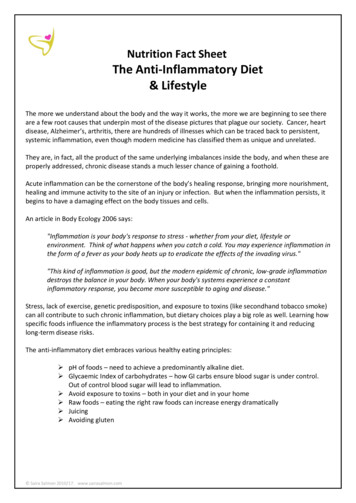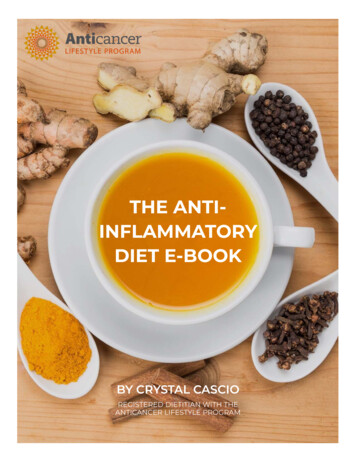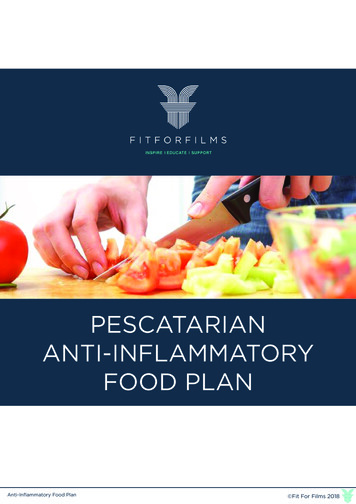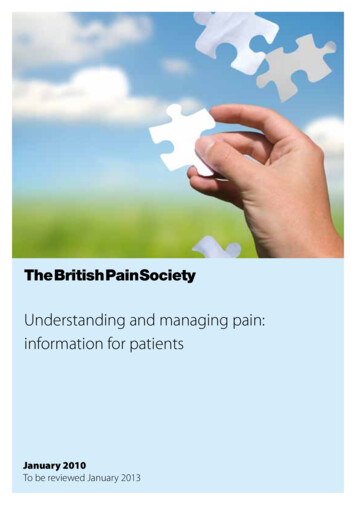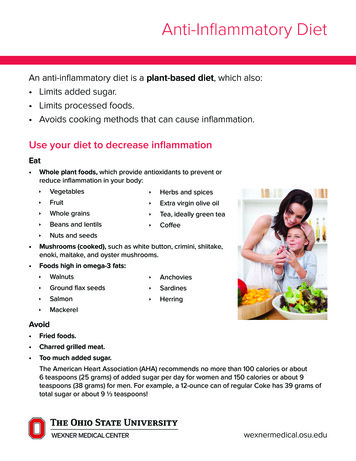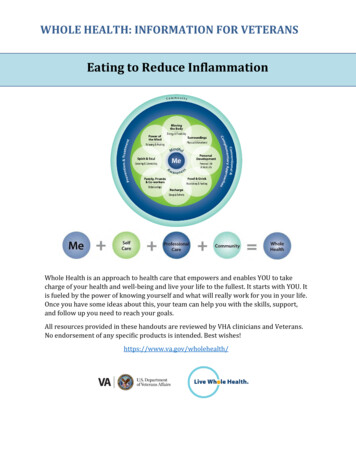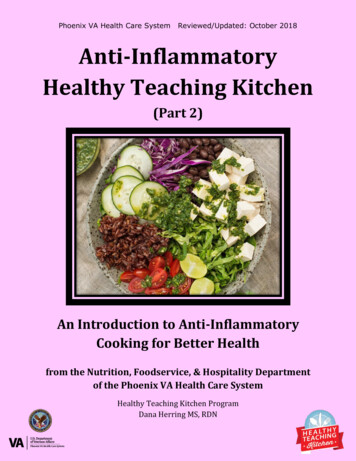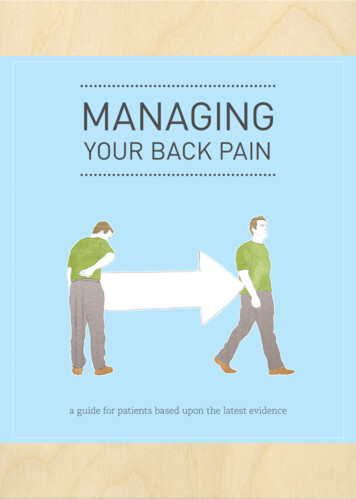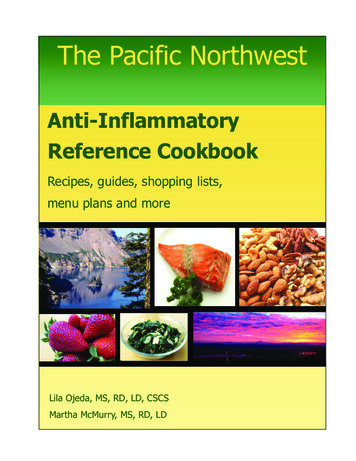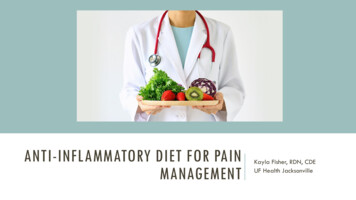
Transcription
ANTI-INFLAMMATORY DIET FOR PAINMANAGEMENTKayla Fisher, RDN, CDEUF Health Jacksonville
ABOUT THE AGING AND INTEGRATIVE PAINASSESSMENT AND MANAGEMENT INITIATIVE (AI-PAMI)AI-PAMI is a comprehensive project addressing non-opioid pain management in adults ages 50 andolder living in Northeast Florida. The overall goal of AI-PAMI is the advancement of innovative paineducation and patient care through the development of provider and patient workshops focused onintegrative pain management.Funding provided by Florida Blue Foundation and the Florida Medical Malpractice Joint UnderwritingAssociation.Visit pami.emergency.med.jax.ufl.edu to learn more.Contact PAMI at pami@jax.ufl.edu or 904-244-4986.
PRESENTATION INFORMATIONKayla Fisher is a Registered Dietitianand has worked at UF HealthJacksonville for seven years. Shecompleted her post-graduate work anddietetic internship at Mayo ClinicJacksonville. Kayla works in anoutpatient clinic educating andcounseling patients with many differentchronic diseases.
WHAT IS INFLAMMATION? Inflammation is your body’s natural defense against dangers like bacteria, viruses,irritants, toxins and physical trauma. You usually feel inflammation as swelling, redness, heat and pain. When inflammation runs rampant, it can disrupt your immune system and lead to avariety of chronic diseases including chronic pain.
LIFESTYLE THERAPY’S ROLE Lifestyle therapy includes quitting smoking, improving nutrition, maintaining healthybody weight, staying active, sleeping well, and managing stress. Lifestyle therapy can support improvement in chronic pain symptoms such as backpain, inflammation and functional ability.
LIFESTYLE THERAPY’S ROLE A healthy diet can support weight loss and combat pain. Physical activity supports weight loss. Inactivity can make pain worse. Excess weight can increase pain and complicate other health issues like bloodpressure, cholesterol and joint issues. We have proven options for making small steps toward healthy changes that arepossible for all bodies.
WHAT DOES MY DIET HAVE TO DO WITH THIS? Research has shown that anti-inflammatory diets can help reduce pain,inflammation and stiffness caused by several painful conditions such as arthritis andmusculoskeletal pain.
ANTI-INFLAMMATORY DIET OVERVIEW Not a diet but a healthy eating pattern. Encourages whole foods over processed foods. Rich in plant foods such as fruits, vegetables, beans, nuts, whole grains and healthyfats. Limits added sugars, processed oils, red meat and processed meats. Many other health benefits!
FOODS’ IMPACT ON foods Sugar-sweetened beverages Vegetables Added sugars & refined carbs Fruits Processed meats Whole-grains Solid fats, trans fats, vegetable oils Legumes, nuts, seeds Fried foods Healthy fats Dairy (?) Herbs & spices Water
MORE FRUITS AND VEGETABLES Eat fruits and vegetables with every meal. Aim for five to nine servings daily. Choose fresh or frozen when possible. Fruits and vegetables provide antioxidants, fiber, vitamins and minerals. Great choices include leafy greens, spinach, broccoli and berries.
HEALTHY FATS AND OMEGA 3S Focus on omega-3 fatty acids found in fatty fish like salmon and tuna, walnuts, chiaand flax seeds. Choose unsaturated fats: Olive oil Nuts and seeds Avocado Limit saturated fats as these promote inflammation: Butter Ice cream Red meat, bacon, sausage. Limit use of vegetable oils such as soybean oil.
CHOOSE WHOLE GRAINS Whole or intact grains are minimally processed and rich in fiber and other nutrients. Choose whole grains: Oatmeal Quinoa Brown rice Whole-grain breads or crackers (if consuming) Whole-grain pastas Limit or avoid refined grains and starches: White bread, biscuits, bagels, chips, crackers White rice or white pasta Sugared cereals, granola bars, muffins, sweets
AVOID ADDED SUGARS Added sugar or concentrated sweets provide extra sugar andcalories contributing to inflammation and obesity. Significantly cut back or eliminate added sugars such as: Soda, juices, sweet tea, sports drinks, lemonade. Cookies, candies, cakes, ice cream. Read food labels for added sugars.
LESS RED/PROCESSED MEAT Avoid red meat such as beef and burgers. Avoid processed meats such as bacon, sausage, corn dogs, bologna. Avoid fried meats. Choose healthier proteins such as fish, skinless chicken, eggs in moderation, andplant proteins such as beans, nuts, tofu.
DAIRY? Dairy is slightly controversial. Some suggest avoiding it while others consider it anutritious food group. Avoid dairy that is high in fat and/or sugar such as whole milk and ice cream. Eat dairy that is high in protein and probiotics such as Greek yogurt and low-fatcottage cheese.
MEDITERRANEAN DIET The Mediterranean Diet is proven to be one of thehealthiest diets for the prevention and management ofchronic disease. It is also “anti-inflammatory”. Mostly high-fiber plant foods. Fish more often. Moderate in lean chicken, eggs, yogurt. Very limited in red meat and sweets. Built on a foundation of physical activity!
DON’T FORGET PHYSICAL ACTIVITY!Research shows that physical activity can help manage more health conditions: Physical activity can decrease pain for those with osteoarthritisReduce disease progression for hypertension and type 2 diabetesReduce symptoms of anxiety and depressionImprove cognition for those with dementia, multiple sclerosis, ADHD, and Parkinson’s diseaseExercise can improve back flexibility, improve healing and reduce stiffness
DON’T FORGET PHYSICAL ACTIVITY!Fitting regular exercise into your daily schedule may seem difficult at first. Trythese ideas to increase your daily movement: Break your exercise into mini-workouts of 10 minutes at a time.Park farther away from the entrance to storesWalk the dog every dayTake the stairs instead of the elevatorFind a workout buddy to help you stay accountable and make it funPractice a relaxing form of strengthening exercise, like yoga or tai chiChoose activities you enjoy. It's easier to make exercise a regular part of your life if you have fun doing it.Start a walking program of just five minutes a day, adding a couple minutes every other day or so until you areup to 20 to 30 minutes of daily walking Give yourself goals. The goals should challenge you, but also be realistic.
QUESTIONS?
REFERENCESDean, E., & Söderlund, A. (2015). What is the role of lifestyle behaviour change associated with noncommunicable disease risk in managing musculoskeletal health conditions with special reference to chronicpain?. BMC musculoskeletal disorders, 16, 87. https://doi.org/10.1186/s12891-015-0545-yU.S. Department of Health and Human Services and U.S. Department of Agriculture. 2015 – 2020 DietaryGuidelines for Americans. 8th Edition. December 2015. Available at -2020-dietary-guidelines/.Seaman, D. R., (2002). The diet-induced proinflammatory state: A cause of chronic pain and otherdegenerative diseases?, Journal of Manipulative and Physiological Therapeutics, Volume 25, Issue 3, Pages 168179, https://doi.org/10.1067/mmt.2002.122324Gordon, R., & Bloxham, S. (2016). A Systematic Review of the Effects of Exercise and Physical Activity on NonSpecific Chronic Low Back Pain. Healthcare (Basel, Switzerland), 4(2), //medlineplus.gov/exerciseandphysicalfitness.html
MEDITERRANEAN DIET The Mediterranean Diet is proven to be one of the healthiest diets for the prevention and management of chronic disease. It is also “anti-inflammatory”. Mostly high-fiber plant foods. Fish more often.

